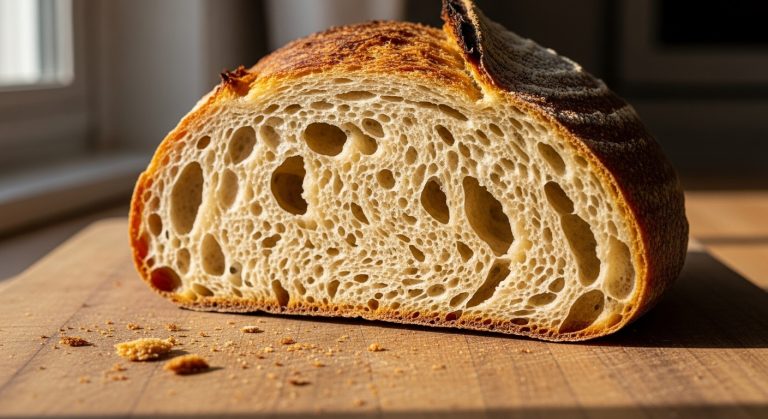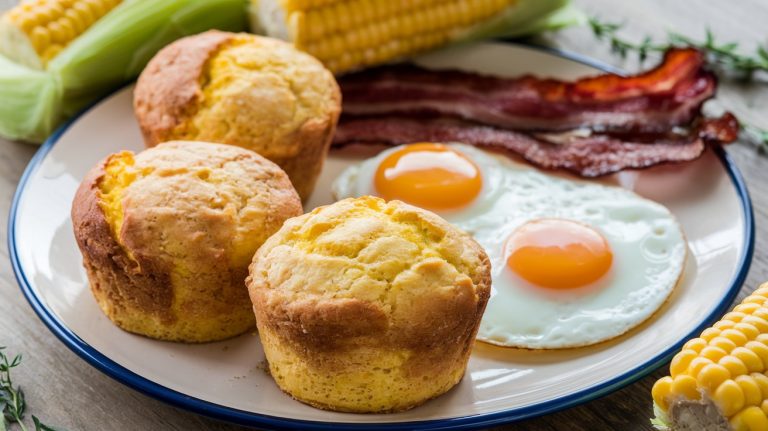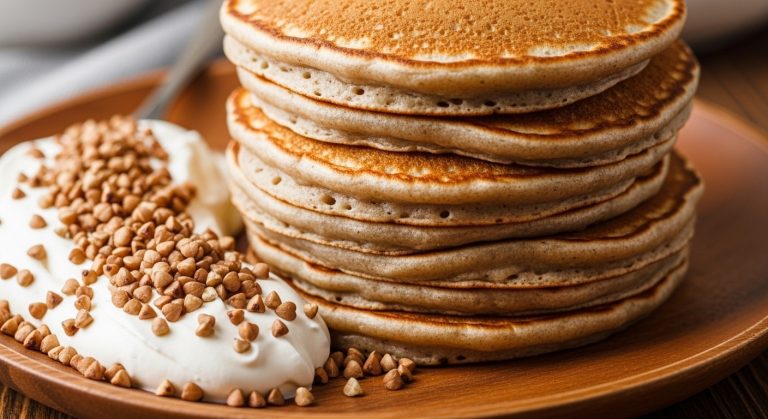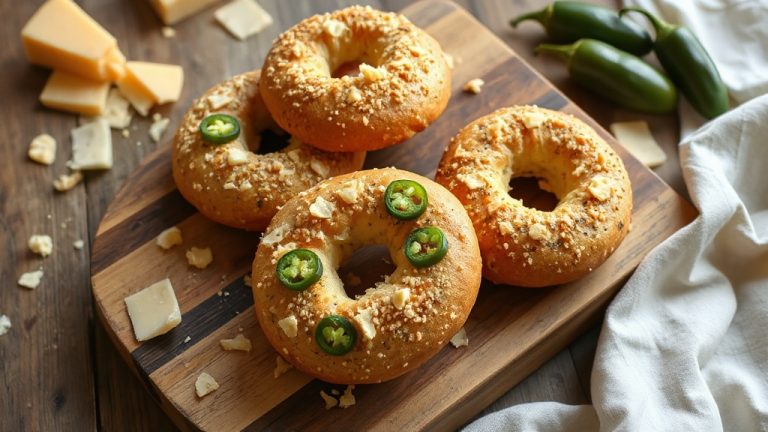Chocolate Chip Sourdough Cookies: Recipe for Consistent Results
To make chocolate chip sourdough cookies, start by browning butter for nutty depth, then mix with equal parts granulated and brown sugar for chewiness. Add your sourdough starter to introduce a subtle tang and complex flavor.
Use precise flour ratios for ideal texture, and rest the dough chilled for up to 48 hours to develop chewiness and richness. Bake at 350°F until edges are golden and centers remain soft. Master these steps, and you’ll unveil each element’s full potential.
Key Takeaways
- Use a mix of all-purpose and bread flour with 100% hydration sourdough starter for balanced texture and tangy flavor in cookies.
- Brown butter before mixing to add nutty, toffee-like notes and enhance chewiness in chocolate chip sourdough cookies.
- Rest and chill dough for 24-48 hours to deepen sourdough flavor, improve texture, and control cookie spread.
- Incorporate equal parts granulated and brown sugar for sweetness and chewiness, complemented by semi-sweet chocolate chips.
- Sprinkle flaky sea salt on dough before baking to balance sweetness and highlight chocolate and sourdough complexity.
Complete Recipe Guide for Sourdough Chocolate Chip Cookies
| Ingredients | Process |
|---|---|
| 113-185g unsalted butter | Brown the butter over medium-low heat until golden brown specks form, then transfer to heatproof bowl to cool completely |
| Equal parts granulated and brown sugar (typically 150-200g each) | Combine cooled brown butter with both sugars, whisk until light and fluffy |
| 1-3 eggs or egg yolks | Whisk eggs and vanilla extract into butter-sugar mixture until well combined |
| 125-220g sourdough starter (100% hydration, discard or active) | Stir in sourdough starter thoroughly for uniform tanginess throughout dough |
| 190-375g all-purpose flour | Separately whisk all dry ingredients to evenly distribute leavening agents |
| Optional: ¾ cup bread flour | Mix with all-purpose flour for enhanced chewiness |
| ½-1 teaspoon baking soda | Include with flour mixture for proper rise |
| ¼-½ teaspoon salt (per cup of flour) | Add to dry ingredients for balanced flavor |
| 340-360g semi-sweet chocolate chips | Gently fold in chocolate chips after combining wet and dry ingredients |
| Optional: flaky sea salt for topping | Sprinkle on top before baking for savory-sweet contrast |
Ingredients for Sourdough Chocolate Chip Cookies

When you bake sourdough chocolate chip cookies, selecting the right ingredients is essential to achieving the ideal balance of texture and flavor. Start with flour: all-purpose is standard, measured precisely between 190 to 375 grams, while bread flour may be added for chewiness.
Both all-purpose and bread flours are suitable; combining 1 cup all-purpose with ¾ cup bread flour yields varied results that affect cookie texture and appearance. Using a precision baking scale ensures that flour measurements are accurate, which significantly influences the final cookie quality.
Your sourdough starter, typically at 100% hydration, ranges from 125 to 220 grams, influencing dough consistency and tanginess. Both discard and active starter can be used in the recipe, as baking soda helps the cookies rise, so using discard or active starter works well.
Use a balanced sugar mix—usually equal parts granulated and light or dark brown sugar—to control sweetness and chew.
Fat comes from unsalted butter, 113 to 185 grams, contributing richness and texture; eggs, 1 to 3 yolks or whole, bind and tenderize.
Leavening relies on ½ to 1 teaspoon baking soda, with salt enhancing flavor.
Finally, semi-sweet chocolate chips between 340 and 360 grams provide the signature bittersweet contrast.
Preparing and Mixing the Cookie Dough
Although browning butter requires careful attention, it markedly deepens the flavor profile of your sourdough chocolate chip cookies. Melt butter over medium-low heat, increasing to medium until golden brown specks form, then transfer to a heatproof bowl to cool completely. The browned butter serves as the base for dough, imparting a rich nutty taste unique to this recipe.
Combine cooled brown butter with white and brown sugars, then whisk in eggs and vanilla extract until light and fluffy. Stir in sourdough discard thoroughly for uniform tanginess. Using a sourdough base can also contribute to a lower glycemic index, making these cookies a slightly healthier treat.
Separately, whisk all-purpose flour, optional bread flour, baking soda, baking powder, and salt to evenly distribute leavening agents.
Gradually fold dry ingredients into the wet mixture, mixing until just a few flour streaks remain to avoid excess gluten.
Finally, gently fold in chopped chocolate or chips, aiming for a firm, slightly sticky dough ready for portioning.
Importance of Resting and Chilling the Dough

You’ll notice that resting and chilling the dough intensifies the sourdough’s tang and caramelized flavors through slow fermentation and hydration.
This process also enhances dough texture by allowing gluten to develop and fat to firm, resulting in chewier, thicker cookies. Resting the dough prevents excessive spreading during baking, which helps maintain the cookie’s shape and texture.
Skipping this step compromises both flavor complexity and the ideal cookie structure you’re aiming for.
Flavor Development
Since dough resting and chilling trigger crucial biochemical processes, they play an essential role in developing the complex flavor profile of chocolate chip sourdough cookies. During chilling, enzymatic reactions convert starches and proteins into nuanced flavor compounds while yeast and bacteria produce desirable acids, intensifying sourness and depth.
Chilling dough for 30 minutes significantly reduces cookie spread during baking, which helps maintain the desired texture and shape. Using a flour with strong gluten structure enhances the dough’s ability to retain gases and develop flavor during these processes.
Prolonged resting, from 24 to 72 hours, allows sugars to absorb liquids fully, balancing sweetness and moisture and promoting caramelization precursors. Fat solidification during chilling delays melting, modulating flavor release timing.
You’ll notice that dough aged several days yields pronounced tangy sourdough notes and richer, multi-dimensional aromas. Covering the dough airtight prevents oxidation and moisture loss, preserving flavor integrity during fermentation.
Skipping or shortening this step results in flatter, less developed flavor that lacks the characteristic complexity of properly rested sourdough cookie dough.
Texture Improvement
When you rest and chill sourdough cookie dough, the texture improves markedly due to multiple physical and chemical changes. Chilling firms the butter, preventing excessive spreading and producing structurally sound cookies with defined shapes. This technique mirrors best practices in freezing sourdough bread to preserve moisture and texture.
Resting activates gluten formation as flour proteins hydrate fully, enhancing dough elasticity and resulting in a chewier, less crumbly texture. Additionally, resting the dough allows oats to absorb liquids, which improves hydration and adds to the overall texture.
Hydration during chilling balances moisture throughout the dough, reducing stickiness and cakeyness while promoting even crumb development.
Chemical reactions slow enzymatic activity, stabilizing the dough and enhancing browning for a slight crispness on edges.
Practically, chilled dough is easier to handle—less sticky and more uniform in consistency—allowing precise shaping and consistent baking results.
Extended refrigeration, ideally 24 hours, considerably elevates dough cohesion and texture compared to shorter chilling periods. Moreover, resting for up to 48 hours develops the sourdough flavor, adding a subtle tanginess and richer taste to the cookies.
Baking Guidelines for Perfect Texture
Although achieving the ideal texture in sourdough chocolate chip cookies requires attention to multiple factors, mastering butter preparation and dough handling plays a pivotal role.
Start by browning butter to enhance flavor and promote chewiness; cool it before blending with eggs to prevent scrambling. Browning butter until it develops golden color with flecks of milk solids is essential for the cookie’s distinctive chewy texture.
Cream softened butter with sugars gently to create a light, fluffy dough, avoiding overmixing to prevent toughness. Mix dry ingredients separately for even leavening, then fold in chocolate chips carefully to maintain dough integrity.
Chill dough 12–24 hours to tighten structure and deepen flavor but avoid over-fermentation to prevent cakiness. Using inactive sourdough discard rather than active starter ensures the dough does not rise like bread, maintaining a tender cookie texture.
Bake at 350°F (177°C) for 10–12 minutes, removing cookies when edges are golden and centers are soft.
Use parchment paper and cool on wire racks to prevent overbaking and guarantee excellent texture.
Flavor and Texture Profile Explained

Because sourdough starter introduces natural acidity, you’ll notice a subtle tang that distinguishes these cookies from traditional chocolate chip varieties. This mild sourness, balanced by sweetness from sugars and browned butter, adds depth without overpowering. Utilizing sourdough discard not only reduces waste but also imparts unique flavor notes to baked goods.
Sourdough starter adds a subtle tang, enhancing depth and complexity beyond classic chocolate chip cookies.
Browning butter caramelizes milk solids, imparting nutty, toffee-like notes that enrich richness and promote crispy edges with chewy centers. Slow browning reduces water content by about 20%, concentrating flavors and improving texture. Combining ingredients properly and allowing gluten development ensures the dough achieves the ideal balance of tenderness and structure.
The dough’s texture benefits from egg yolks and balanced flour types, preventing cakey outcomes while supporting tenderness.
Resting the dough enhances flavor development and moisture distribution, creating a harmonious interplay of tang, caramel, and bittersweet chocolate. Resting for up to 24 hours allows the dough to hydrate fully and the butter to resolidify, resulting in fudgier, chewier cookies.
The semi-sweet chips complement the sourdough’s complexity, while a flaky sea salt sprinkle can elevate sweetness and chocolate richness, resulting in a sophisticated, indulgent cookie with layered aromas and precisely balanced flavors.
Tips for Enhancing Your Cookies
To enhance your cookies, start by browning the butter to reduce moisture and amplify a nutty, complex aroma. This step is crucial as it deepens flavor and adds a unique dimension to the final cookie. Chilling the dough for at least 2 hours also allows the fats to solidify, which helps control spreading and develop flavor depth.
Finally, sprinkle flaky sea salt atop the dough before baking to elevate chocolate richness with a subtle, savory contrast. For best results, adjust ingredient ratios carefully to maintain an ideal dough consistency, similar to the precision needed in sourdough bagel preparation.
Optimal Dough Chilling
When you chill sourdough cookie dough, the butter solidifies, which slows its melting during baking and controls the spread, resulting in thicker, chewier cookies with better shape retention.
Chilling also allows sugar to absorb moisture, thickening the dough and limiting excess liquid that promotes spreading. This firmer dough enhances portioning accuracy, especially when using a scoop, ensuring uniform cookies.
Enzymatic activity during chilling breaks down carbohydrates into simpler sugars, deepening flavor complexity with notes of butterscotch and caramel.
Ideal chilling ranges from 24 to 48 hours, balancing chewiness and crispness while preventing dough drying.
Avoid freezing unless storing long-term, and store dough airtight to maintain moisture and prevent flavor loss.
If dough firms excessively, briefly remix before portioning to restore workability without compromising texture.
Chilling sourdough dough also promotes gluten relaxation, improving dough elasticity and texture.
Butter Browning Benefits
Although browning butter requires careful attention, it profoundly enhances your sourdough cookies by developing complex nutty, caramel, and toasted bread flavors through Maillard reactions and caramelization.
This process evaporates water, concentrating butterfat and intensifying flavor without losing fat content. The resulting browned butter imparts a bold, toasty butteriness that deepens cookie flavor and texture.
To optimize your cookies with browned butter, consider these tips:
- Incorporate browned butter near the end of mixing to preserve its delicate flavors.
- Chill browned butter dough to promote thicker, chewier cookies with enhanced flavor.
- Adjust moisture slightly, adding water or milk if dough feels too dry due to moisture loss.
- Monitor browning closely to avoid burnt notes that can overpower your cookies.
These techniques ensure your cookies achieve superior flavor complexity and texture. Using a digital baking thermometer can help you precisely monitor the temperature during the browning process for optimal results.
Salt Enhancements
How does salt transform your chocolate chip sourdough cookies beyond mere seasoning? Salt balances sweetness, enhances chocolate depth, and emphasizes sourdough tang.
Adding flaky sea salt atop before baking gives a crunchy burst, while kosher salt works best mixed into dough for even flavor and improved texture. Proper salt quantity (¼–½ tsp per cup flour) guarantees complex taste without overpowering.
Chilling the dough before baking also helps to preserve the salt’s impact by preventing excessive spreading and flavor dilution, ensuring each bite delivers the intended balanced flavor. Incorporating salt after the initial mixing helps control yeast activity and enhances the overall cookie flavor.
| Salt Type | Effect |
|---|---|
| Flaky Sea Salt | Crunchy texture, burst of saltiness |
| Kosher Salt | Even distribution, strengthens gluten |
| Fine Salt | Smooth integration, subtle flavor lift |
Apply salt just before baking to preserve texture and flavor contrast, unlocking your cookies’ full savory-sweet potential.
Creative Variations to Try
Exploring creative variations lets you tailor chocolate chip sourdough cookies to your preferred flavor and texture profiles. You can enhance aromatic complexity by adding ground cinnamon, ginger, or nutmeg. Using fresh, high-quality flour ensures the best flavor and texture in your cookies.
Texture shifts are achievable with bread flour for chewiness or brown butter for deeper, nutty notes. Utilizing different flours such as einkorn can also add nutritional benefits and unique textures to your cookies.
Chocolate choice affects sweetness and bitterness, while fermentation methods influence tang and softness.
- Add 1.5 tsp ground cinnamon or 0.5–1 tsp ginger for warm, spicy undertones
- Use bread flour and brown butter to increase chewiness and caramelized richness
- Experiment with 1.5–2 cups dark chocolate chunks for intense, varied chocolate pockets
- Chill dough 12–24 hours to deepen flavor via fermentation and improve texture
Frequently Asked Questions
Can I Use Sourdough Starter Instead of Discard in This Recipe?
Think of sourdough starter as a live orchestra, while discard is a muted echo. You can use starter instead of discard, but it’ll amplify fermentation, increasing rise and tanginess.
You’ll need to reduce liquids due to starter’s higher hydration, lengthen chilling time to control yeast activity, and watch spread during baking.
Using less starter than discard called for helps avoid over-acidity. Expect richer flavor but adjust carefully for best texture and consistency.
How Do I Store Sourdough Chocolate Chip Cookies to Keep Them Fresh?
Store your cookies in an airtight container at room temperature for up to 7 days to preserve freshness and chewiness. Place a small piece of white bread inside to maintain moisture. Always cool cookies completely on a wire rack before storing to prevent condensation and sogginess.
Avoid containers that allow air exposure, which causes drying. For longer storage, freeze individually wrapped cookies up to 3 months, thawing at room temperature before serving.
What Is the Best Way to Reheat Leftover Sourdough Cookies?
To reheat leftover sourdough cookies, preheat your oven to 350°F (177°C).
Place cookies on a parchment-lined baking sheet to guarantee even warming without sticking.
Heat them for about 5 minutes to preserve moisture and texture.
Avoid microwaving, as it can dry out or toughen the crust.
For best results, wrap cookies lightly in foil or spritz with water before heating to retain softness and prevent drying out.
Can I Freeze the Cookie Dough Before Baking?
Yes, you can freeze cookie dough before baking. Portion your dough into scoops, chill until firm if at room temperature, then freeze on parchment-lined trays to prevent clumping.
Transfer frozen scoops to airtight, freezer-safe containers or bags, removing excess air to avoid freezer burn. Store dough up to three months.
Bake frozen dough directly, increasing bake time to 17-20 minutes at 375°F (190°C) for ideal texture and flavor preservation.
Are These Cookies Suitable for People With Gluten Sensitivities?
It’s a coincidence that sourdough fermentation breaks down gluten, which might make these cookies easier for some with gluten sensitivities to digest. However, they still contain gluten, so if you have celiac disease, you should avoid them entirely.
If you have non-celiac gluten sensitivity, you might tolerate these better due to reduced gluten and FODMAPs, but tolerance varies. Always assess your individual reaction before enjoying sourdough-based treats safely.
Sourdough Success: Where Patience Meets Perfect Cookies
By incorporating sourdough starter into your chocolate chip cookies, you’re tapping into a flavor enhancer that can increase the depth and complexity by up to 30%. This natural fermentation not only boosts taste but also improves texture, giving you a chewier, more satisfying bite.
Remember to rest and chill your dough for best gluten development. With precise baking times and temperatures, you’ll consistently achieve that perfect balance of crisp edges and tender centers every single time.







